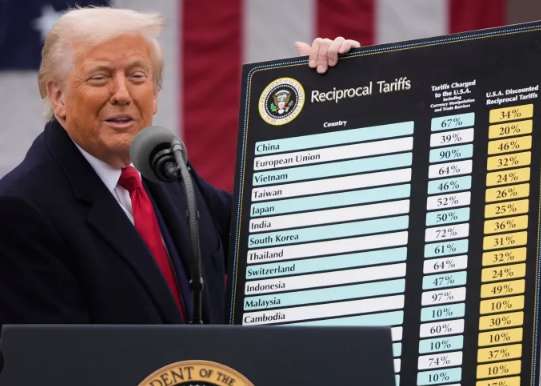Trump Wants, And Will Impose 10%+ Tariffs On More Than 150 Nations
After sending letters to more than 20 countries notifying them of new reciprocal tariffs to be implemented next month, U.S. President Trump has previewed that a wave of tariff letters is coming.On Wed

After sending letters to more than 20 countries notifying them of new reciprocal tariffs to be implemented next month, U.S. President Trump has previewed that a wave of tariff letters is coming.
On Wednesday, July 16, Trump stated at the White House that he would send notices to over 150 countries informing them of the tariff rates the U.S. would impose. “We’ll have well over 150 countries that we’re just going to send a notice of payment out, and the notice of payment is going to say what the tariff rate will be,” Trump told reporters on Wednesday at the White House.
In a media interview released after Wednesday's market close, Trump said he might impose a uniform tariff rate of 10% or 15% on 150 countries. The tariff rate could be 10% or 15%, but he “hasn't decided yet."
Small Nations, Big Pain
When discussing the countries that would receive tariff letters, Trump said on Wednesday that these countries are "not major nations, and their trade volumes with us are not large."
This aligns with Trump's remarks on Tuesday evening.
Trump stated on the 15th that he plans to impose tariffs of over 10% on smaller countries, including those in Africa and the Caribbean.
The report noted that Trump made these comments on the 15th at Andrews Air Force Base, telling the media he might impose a uniform tariff on all these smaller countries. He said the tariffs on goods from at least 100 countries could be "slightly above 10%."
US Secretary of Commerce Lutnick said Tuesday evening that the countries subject to the tariffs Trump mentioned would be those in Africa and the Caribbean, which typically have relatively small trade volumes with the U.S. and play a minor role in Trump's goal of reducing trade imbalances with the rest of the world.
Possible agreement with the EU; too early to predict prospects for U.S.-Canada deal
During Wednesday's trading session, Trump said the best approach for the U.S. is to send trade letters. He also mentioned announcing "some pretty good deals," specifically naming India, stating that negotiations are underway and the two sides are close to an agreement.
After the market closed, Trump said the tariffs to be imposed on August 1 would be "very substantial." He again mentioned India, saying a deal is close.
Trump also stated that the U.S. might reach an agreement with the EU but that he is "indifferent" to whether a trade deal is reached with the bloc. He suggested that the tariff letters sent to the EU could themselves be considered a form of agreement.
Regarding whether a deal could be reached with Canada, Trump said it is too early to draw conclusions.
The day before, on Tuesday, Trump had just announced a trade deal with Indonesia. Trump posted on the social media platform "Truth Social," declaring that the U.S. would impose a 19% tariff on all imports from Indonesia, while U.S. exports to Indonesia would enjoy duty-free treatment and exemption from non-tariff barriers.
The 19% tariff means that, among the more than 20 U.S. trade partners that received tariff letters from Trump over the past week, Indonesia would face the lowest rate. Indonesia became the first trade partner to lower tariffs through a trade agreement after receiving a tariff threat.
Based on the contents of the first wave of tariff letters Trump released on Monday, July 7, 14 countries—including Japan and South Korea—would face tariffs ranging from 25% to 40%, with Indonesia subject to a 32% tariff.
On Wednesday, July 9, Trump's second wave of tariff letters targeted eight countries: Brunei, Algeria, Moldova, Iraq, the Philippines, Libya, and Brazil. The 50% tariff on Brazil was the highest announced under the new reciprocal tariff policy.
Last Thursday, Trump announced that starting August 1, the U.S. would impose a 35% tariff on goods imported from Canada. That same day, Trump also stated he plans to impose a uniform tariff of 15% or 20% on countries that have not yet received tariff letters. According to Xinhua, on Saturday, July 12, Trump announced that starting August 1, the U.S. would impose 30% tariffs on goods imported from the EU and Mexico, respectively.
Disclaimer: The views in this article are from the original Creator and do not represent the views or position of Hawk Insight. The content of the article is for reference, communication and learning only, and does not constitute investment advice. If it involves copyright issues, please contact us for deletion.